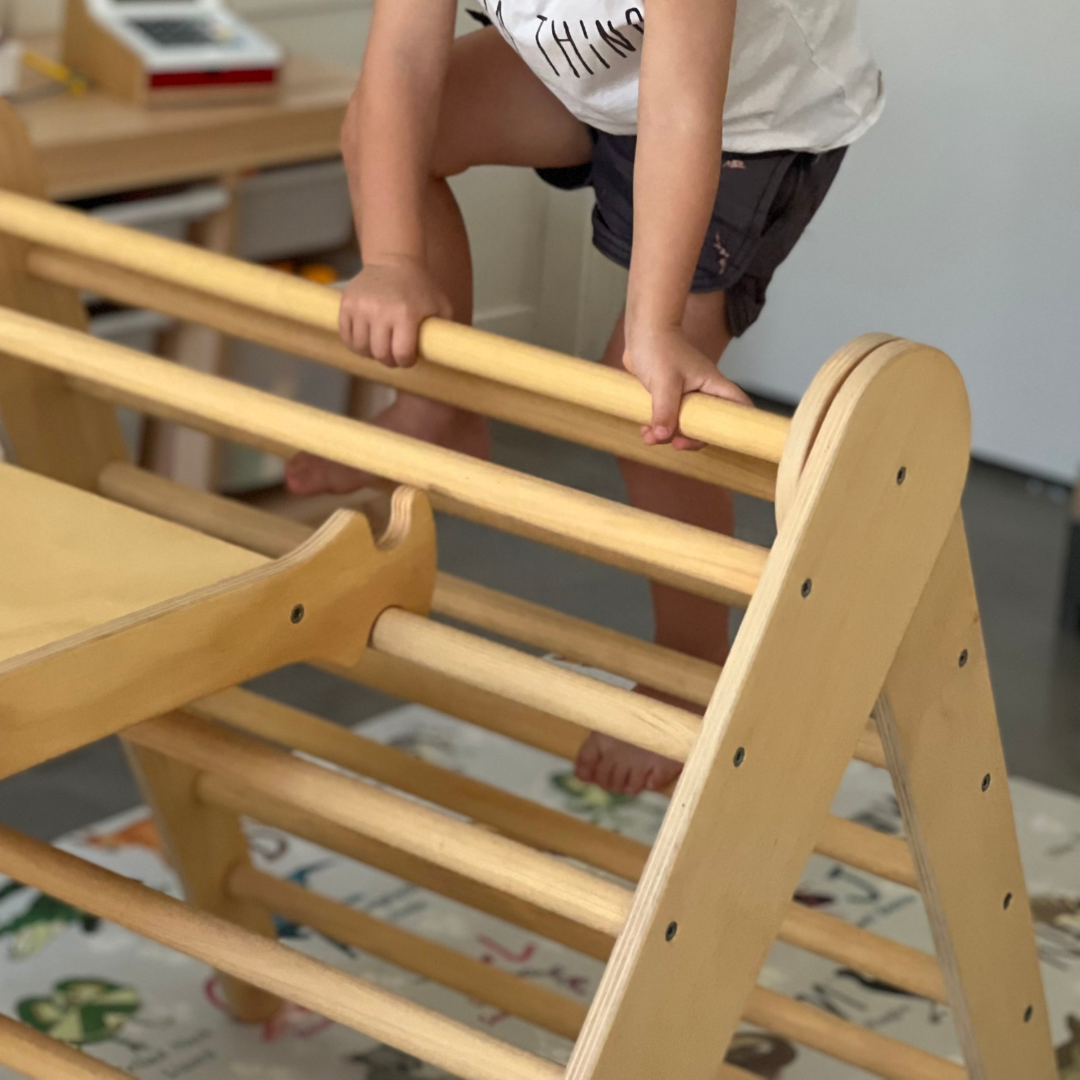
Toddler climbing - why you should embrace it
There is nothing scarier than that moment you realise your little baby has climbed up somewhere dangerous. Toddler climbing is so so scary. Of my three kids, one was a definite skilled climber from an early age. PJ was less than 18 months old the first time I found him on the kitchen bench (I was literally next to him in the pantry making breakfast and I just couldn't believe how quickly he managed it).
This was the start of my quest into finding safe climbing activities for my children. But why did I want to encourage it?? Because they actually need to climb. We are very good these days at recognising the benefits of messy play for sensory development but toddler climbing is also a huge part of sensory development. We have a range of climbing frames set up at home now to encourage our little ones to help support their development at all ages.
Here Alice, an Occupational Therapist explains the benefits of climbing for children of all ages and abilities and why it is important for you to create invitations for your little ones to explore this safely.
The Benefits of Climbing
As an Occupational Therapist I work with a range of children and their families who all have such different strengths and difficulties but I regularly find that my sessions incorporate climbing. Incorporating climbing activities into every day play is not only a motivating and fun activity, but can also assist in functional development.
When we think creatively, we can make the task of climbing easier, more challenging, or more motivating. Below are a few areas and examples of how I use climbing to empower the children I work with and help them achieve their potentials.

Strength and Endurance:
Strength and endurance are used in the development of many of a child’s skills including lifting, pushing, running, carrying as well as postural stability such as the ability to sit upright for long periods of time.
When a child practices climbing at a young age, they are developing both fine motor and gross motor strength and challenging their muscular endurance. Even when considering a child under 1 year of age who is pulling to stand themselves, they are developing strength with their grasp in their hands, as well as their torso and legs.
By using their fingers, hands, wrists and shoulders to pull themselves up when climbing, the strength developed in these upper body limbs will assist them in grasping toys, drinking cups and handles, holding spoons and eventually holding pencils for writing.
By using their core and lower body for pushing and positioning, the strength developed in these core and lower body limbs will assist in developing the strength needed to a variety of tasks such as sit upright and unsupported, stand and run.

Bilateral Coordination:
When a child climbs, they are required to use both sides of their body together. Furthermore, they are using both sides of their body in an interchanging sequence. To do this, children are using bilateral coordination, which may start a little clunky and with practice can develop into a more ‘organised’ or seamless approach.
Bilateral coordination is required for coordinated and controlled movements using both sides of the body. Bilateral coordination requires the ability to integrate both hemispheres of the brain. This means that our left and right limbs can work together simultaneously. A child requires bilateral coordination skills to learn and succeed in tasks. These skills are important for playing, feeding themselves, dressing themselves, grooming and using scissors or handwriting.

Planning, Problem Solving and Attention:
When a child climbs, they are challenging their cognitive abilities as much as their physical abilities. During a climbing task, a child’s brain is processing a range of demands. They are using flexible thinking to navigate questions. Some of their thought process may include, ‘how high do I need to lift my foot?, where should I place my hand next?, how am I going to get down from here?’ and ‘is this too high for me?’.
We can also use our creative hats to further challenge our child’s cognition in the climbing task. For example, we could be teaching our child counting or number and letter recognition. This can be done by asking our child to place their hand on a printed number or letter.
Furthermore, climbing can often be a motivating task, or be easily made into a motivating task, for children who have difficulty with attention. For example, we can use a visual timer and time how many times a child can get up and down the ladder. Alternatively, you can play dress ups and imagine they are Spider-man or Batman as they scale the rungs.

Sensory Processing: (why we encourage toddler climbing)
Climbing supports many sensory processing benefits. When we think creatively we can adapt activities, whilst using climbing as the motivator. For example, we can support tactile discrimination by placing different tactile objects on the rungs and asking a child to touch all of the ‘fluffy’ or the ‘rough’ material as they go.
The two most prevalent sensory benefits gained by climbing however are the development of vestibular and proprioceptive awareness.
Proprioception is essential for our brain to know where our body is in space. It also tells us how hard or soft to use our muscles for specific tasks. Therefore, it is essentially the awareness of how our muscles move. Our proprioceptors are located in our muscles and joints and when our body moves, they provide us with sensory information. Here is some more information on the proprioceptor system.
The vestibular system is located in our inner ear and when our head moves, it receives information. This means that our vestibular system tells our brain where our body is in space. It also tells it how fast or slow we are moving. Vestibular awareness is important for many skills. This includes balancing when learning to walk and sitting upright. You can learn more about the vestibular system here.
Creating a safe space:
To create a safe climbing place to encourage your little explorers, there is a couple of things to keep in mind. Firstly, make sure you purchase quality products. We love the range of Pikler triangles from Nimble Kids. Developed by paediatrician, Dr Emmi Pikler, the Pikler Triangle acts as a building block for gross motor development. It gives children the ability to intuitively discover their abilities and physical limits in their own time. This triangle is also perfect as it can be folded for storage. They come in a range of sizes with add-ons like slides/ramps to make play time fun. At the moment we are encouraging Ruby to stand up using the rungs to pull herself up and to cruise along. And as she gets older we will teach her to climb it safely. Like with all activities though, supervision is essential. We also have ours set up on our baby play mat to help protect little ones while they explore.
